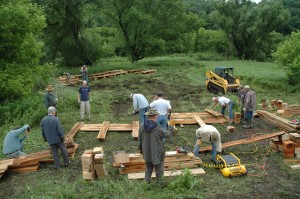 |
| Smith Mountain Lake State Park ranger, John Mitchell, above, inspects the first trailer load of fish habitat blocks to leave the park’s public boat landing Wednesday for their permanent locations at the 15-foot deep level of the Lake. Constructed of polyethylene piping, cinder blocks and concrete, the habitats resemble submerged tree limbs to fish, providing cover from predators, as well as places to rest and raise young. Youth Conservation Corps members, who left the park Saturday for home, constructed the habitats, some 150 of which were distributed in the Lake last week. |
|
One hundred and fifty handmadefish habitats-looking very much like an army of extraterrestrials having a wild hair day–marched in stiff formation down a pier early Wednesday at Smith Mountain Lake State Park, tentacles of black polyethylene pipe crowning their heads and concrete-filled cinder blocks acting as footing.
See the dozens of unique artificial fish habitat models, fish attractors and fish cover used at fishiding.com, the industry leader and only science based, man made and artificial fish habitat, proven to provide all fish with cover they prefer to prosper.
Eight Youth Conservation Corps (YCC) high school crew members, three college-age YYC supervisors and John Mitchell, a ranger at the park, worked in tandem, transferring the soon-to-be-sunken assemblages from a flatbed trailer to the dock, then onto boats for distribution in the Lake. Their loads in place, boats piloted by rangers and filled with teens andfish houses sluiced through the water to various destinations, among them Smith Mountain Lake Community Park, across the main channel and within sight of the launching point at the State Park’s public boat ramp, docks at the park’s Discovery Center and beach, and possibly by some of the park’s lakefront housekeeping cabins if the crew didn’t run out.
Arriving at the park on July 25, the all-female YYC crew also constructed eight picnic pads.
“They dug out the sites level, fitted them with 4′ x 6′ timbers, then filled them with stone,” said Mitchell.
It took the crew almost two days to make the fish habitats in a design and with materials recommended by the Virginia Dept. and Game and Inland Fisheries.
“The girls have done a great job,” said Brian Heft, Smith Mountain Lake State Park manager. “This is something we’ve done for years to support fish structure in the Lake. Fish need assistance to hide from predators, rear their young, and rest. Docks are not necessarily fish structure. Structures come up from the bottom of the Lake. This is an ongoing process. We plan on continuing it.” REBECCA JACKSON





